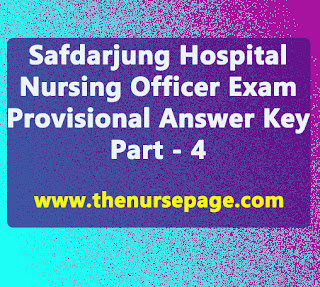What is the best and most accurate method of measuring the medication dosage for infants and children?
The APGAR score should be assessed?
The modern concept of pediatrics means?
Peeling of the palms and the soles is not the characteristic feature of?
Which information obtained from the mother of a child with cerebral palsy most likely correlates to the diagnosis?
Which of the following is best describes the language of a 24-month old?
Which of the following examples represents parallel play?
Assuming that all have achieved normal cognitive and emotional development, which of the following children is at greatest risk for accidental poisoning?
The nurse is caring for a 6 year old client admitted with the diagnosis of conjunctivitis
A patient approached nurse asking for advice on how to deal with his alcohol addiction. Nurse should tell the client that the only effective treatment for alcoholism is?
Nurse is caring for a male client who experience false sensory perceptions with no basis in reality. This perception is known as?
Nurse is developing a plan of care for a female client with anorexia nervosa. Which action should the nurse include in the plan?
A client is experiencing anxiety attack. The most appropriate nursing intervention should include?
A 20 year old client was diagnosed with dependent personality disorder, Which behavior is most likely to be evidence of ineffective individual coping?
A male client is diagnosed with schizotypal personality disorder. Which signs would this client exhibit during social situation?
Nurse is caring a client diagnosed with bulimia nervosa. The most appropriate initial goal for a client diagnosed with bulimia nervosa is?
A neuromuscular blocking agent is administered to a client before ECT therapy. The nurse should carefully observe the client for?
A 75 year old client is admitted to the hospital with the diagnosis of dementia of the Alzheimer’s type and depression. The symptom that is unrelated to depression would be?
Nurse is aware that major health complication associated with intractable anorexia nervosa would be?
A 39 year old mother with obsessive-compulsive disorder has become immobilized by her elaborate hand washing and walking rituals. Nurse recognizes that the basis of Obsessive compulsive disorder is often?
A patient with borderline personality disorder who is to be discharged soon threatens to “do something” to herself if discharged. Which of the following actions by the nurse would be most important?
A patient with antisocial personality disorder belches loudly. A staff member asks “Do you know why people find you repulsive?” this statement most likely would elicit which of the following client reaction?
Which of the following approaches would be most appropriate to use with a client suffering from narcissistic personality disorder when discrepancies exist between what the client states and what actually exist?
Which of the following foods would the nurse eliminate from the diet of a client in alcohol withdrawal?
A woman is 37 weeks pregnant and she is bleeding profusely with no pain is suggestive of?
Puerperal woman is more susceptible to venous thrombosis due to?
The breast feeding mother of an infant with lactose intolerance asks the nurse about dietary measures. The nurse tells the mother to avoid?
The cause of change in size and appearance of breasts during pregnancy?
A pregnant woman has a positive history of genital herpes but has no lesions during the present pregnancy. The nurse should plan to provide which of the following information to the client?
A rubella vaccine is prescribed to be administered to a two days postpartum client. The nurse preparing to administer the vaccine develops a list of the potential risks associated with this vaccine. The nurse reviews the list with the client and the cautions the client to avoid?
A prenatal client with a history of heart disease has been instructed on care at home. Which statement if made by the client would indicate that client understands her needs?
A contraction stress test is scheduled for the pregnant client, and the client asks the nurse about the test. The nurse tells the client that?
A client is scheduled for a pap smear. The nurse provides instructions to the client regarding preparation for the test?
The nurse is teaching a pregnant client about the morning sickness in pregnancy. Which of the following sign & symptom would indicate a need for further education?
A nurse needs to check the most important parameter if patient is on magnesium sulphate therapy?
After scoring on the next page, click “Give Me More”, we have recommendations for you!
